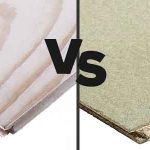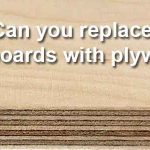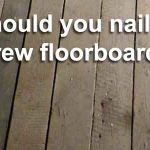The two most common types of sub floor used in UK properties, are timber floorboards and chipboard flooring. Standard floorboards are usually made from softwoods, such as pine, and chipboard flooring is a manufactured wood, which usually comes in sheets.
Both are popular for different reasons, and if you want to, replacing floorboards with chipboard flooring is certainly possible . It is also possible to go the other way, and replace chipboard flooring with standard floorboards. Both are usually tongue and groove, so you can often patch areas with one or the other, and they will fit together quite well.
Also, there are also less common floor board types such as Plywood tongue and groove flooring if you are looking for other options.
In this article we will be looking at the pros and cons of each type of flooring, as well as some other alternatives that you may consider.
Chipboard flooring vs floorboards

Before you decide to replace your floorboards with chipboard flooring, it is worth considering the pros and cons of each type of sub floor. Below we have listed some of the main pros and cons, of each type of flooring:
Pros and cons of chipboard flooring
Pros
- Cheaper per square meter – In general chipboard flooring does tend to be cheaper than standard floorboards. Although you will pay slightly more, if you opt for a moisture resistant chipboard flooring.
- Quicker and easier to lay – Due to the size of chipboard flooring (usually 2400mm x 600mm) it can be laid much quicker. The boards span a much larger area, and as a result, they require less cuts to fit to the joists. If you are hiring someone to do the work, this could be a significant difference in time and labour costs.
- Less chance of creaky floorboards – This is not to say that chipboard flooring will never make any noise when walked on. However, they tend to make less noise than squeaky floorboards. To avoid movement and noise, as much as possible, you should glue the tongue and groove joints and screw the board for the best result.
Cons
- Doesn’t like water – When chipboard gets wet it absorbs moisture. This causes it to expand and deteriorate. Therefore, they will not do well in areas that are likely to suffer with excess moisture or damp. To mitigate this problem, make sure you are using moisture resistant chipboard.
- Harder to remove and access below – Once chipboard is in place it is harder to remove and replace them. This could be required if you need to access piped or wires running in the joists, or if you need to replace boards. Also, the boards are big, so removing them can much more disruptive.
Pros and cons of timber floorboards
Pros
- Slightly more resistant to moisture – Whilst its not a good idea to get your floorboards wet, they will not expand and fall apart like chipboard can. With that said. They are more susceptible to rot and woodworm infestation when damp.
- Much easier to access under boards – As we already mentioned, one of the major disadvantages of chipboard flooring, is they are difficult to remove and access the joists and void below. This can be very frustrating when you need to access plumbing or electrics. With timber floorboards, it is much easier, as you can simply remove individual boards.
- Potential to have exposed floors – Obviously this is not an option with chipboard. However, a timber floor can be very aesthetically pleasing. Especially if you use high quality floorboards and finish them well.
Cons
- More expensive – Timber floorboards are going to be more expensive over the same area. More work goes into producing timber floorboards and the quality of wood is better. As a result, you will pay more.
- Take longer to install – Timber floorboards take significantly longer to install than chipboard flooring. A single board is roughly 25% the width of a chipboard sheet. This means, 4 rows of boards, will cover the same width as a sheet of chipboard. That’s 4 times as much measuring, 4 times as much cutting, and considerably more fixings (including gluing joints).
Also, if you are paying a joiner to do the work, you will likely pay more for the labour. This is simply due to the extra time it will take.
As you can see, there are several pros and cons for each method. The one you choose, is entirely up to you. Based on the info above, you should be able to weigh up the pros and cons of your own personal situation.
Can you replace floorboards with Plywood or MDF?
Depending on the scale of the job when replacing floorboards, you may also be considering other types of manufactured wood to replace them. Two common boards that you can find at any builder’s merchant or timber yard, are Ply and MDF. So, could you use either of these?
Plywood is strong and durable, and just like chipboard it is man made. However, it is produced in a different way and tends to be much more dense and solid than chipboard. Whilst this means it is possible to use this on a floor, it is not usually recommended. Plywood generally comes in 2400mm x 1200mm sheets. Just like chipboard, access would be a nightmare over large areas.
Also, it doesn’t have a tongue and groove edge. This mean that the edges could lift and become uneven
However, if you are only patching a small area and don’t have access to spare floorboards, it is acceptable to replace one or two boards with plywood (in my opinion).
When it comes to MDF, it is not advised to use this as a replacement for floorboards. MDF is made with a combination of wood powder, glue, and chemicals. It tends to have a lot of flex in the board, which makes it a terrible option for use in a sub floor. It is also highly susceptible to moisture damage.
Conclusion
As you can see replacing floorboards with chipboard flooring is definitely possible. However, there are several pros and cons you should take into consideration. The answer to whether you should, is not one size fits all, and it can vary on a variety of different factors, Including:
- Cost
- Ease of installation
- Access after fitting
- Exposure to damp or moisture
- Etc
Hopefully the info in this article has given you enough information to make an informed decision.




